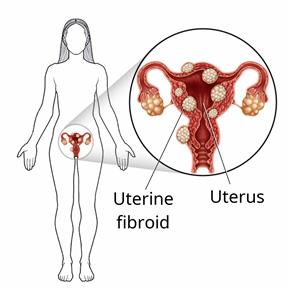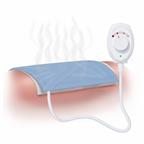Fibroids in the Uterus: What to Know

Fibroids are benign tumors that grow in the uterus. Benign means that they are not cancer. You may have one or more than one fibroid. Fibroids vary in size, weight, and where they grow in the uterus. Some can become quite large. Most fibroids do not need to be treated by a health care provider.
What are the causes?
The cause of this condition is not known.
What increases the risk?
You are more likely to develop this condition if:
You're in your 30s or 40s and you've not gone through menopause. Menopause is a time when a person no longer has a period.
You have family members who have had fibroids.
You're of African American descent.
You started your monthly period at age 10 or younger.
You've never given birth.
You're overweight or obese.
You have a diet low in fruits, vegetables, and vitamin D.
What are the signs or symptoms?
Many people do not have symptoms. If you have symptoms, they may include:
Heavy bleeding during a period.
Bleeding between periods.
Pain and pressure in the area between the hip bones (pelvis).
Pain during sex.
Bladder problems, such as needing to pee right away or more often than usual.
Inability to get pregnant.
Not being able to carry a pregnancy to term (miscarriage).
How is this diagnosed?
This condition may be diagnosed based on:
Your symptoms and medical history.
A physical exam, including feeling for any tumors.
Imaging tests, such as an ultrasound or MRI.
How is this treated?
This condition may be treated with:
- Medicines.
- Surgery. This may be done to:
- Other procedures to shrink the fibroids. Your provider may do:
An RFA (radiofrequency ablation). This uses heat and radio energy to shrink the fibroids.
An MRI-guided ultrasound. This uses ultrasound waves to shrink the fibroids. This is done through the skin. No cuts are made on the skin.
Follow these instructions at home:
Medicines
-
Take your medicines only as told.
-
Ask your provider if you should take iron pills or eat more iron-rich foods, such as dark green, leafy vegetables. Heavy bleeding from your period can cause low iron levels in the body.
Managing pain

-
Put heat on your back or belly as told.
- Use the heat source that your provider recommends, such as a moist heat pack or a heating pad. Do this as often as told.
-
If your skin turns red, take off the heat right away to prevent burns. The risk of burns is higher if you can't feel pain, heat, or cold.
General instructions
Contact a health care provider if:
-
You have pain in your pelvis or back. Or cramps in your belly that do not get better with medicine or heat.
-
You get new bleeding between your periods.
-
You have worse bleeding during your period, or between them.
-
You feel weaker or more tired than usual.
-
You feel light-headed.
This information is not intended to replace advice given to you by your health care provider. Make sure you discuss any questions you have with your health care provider.

